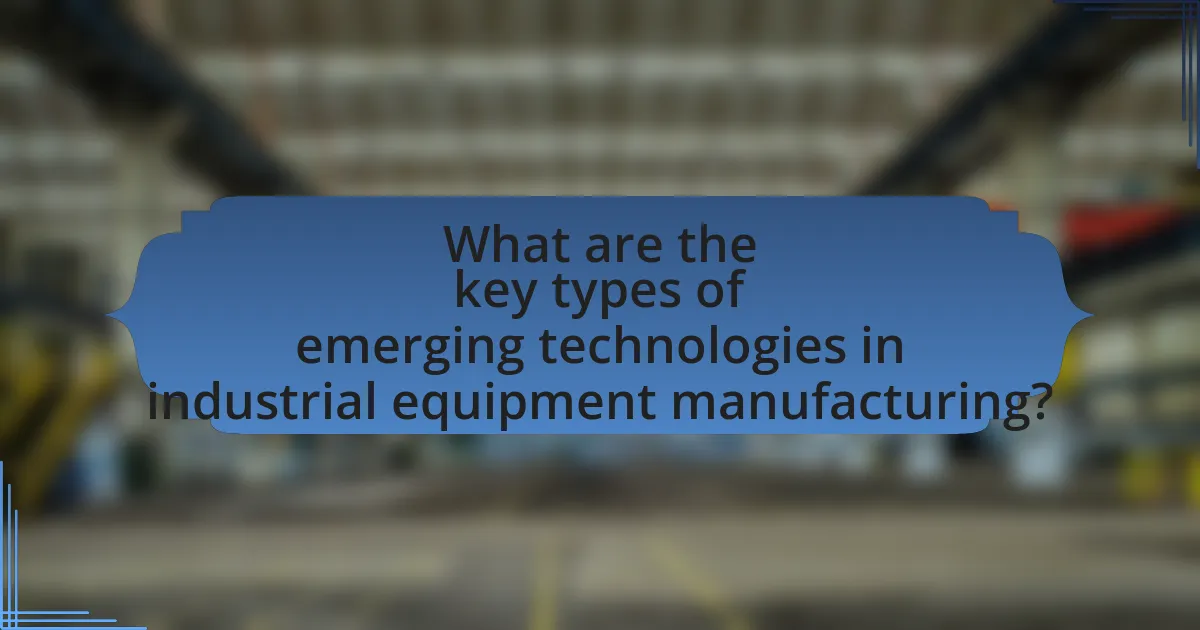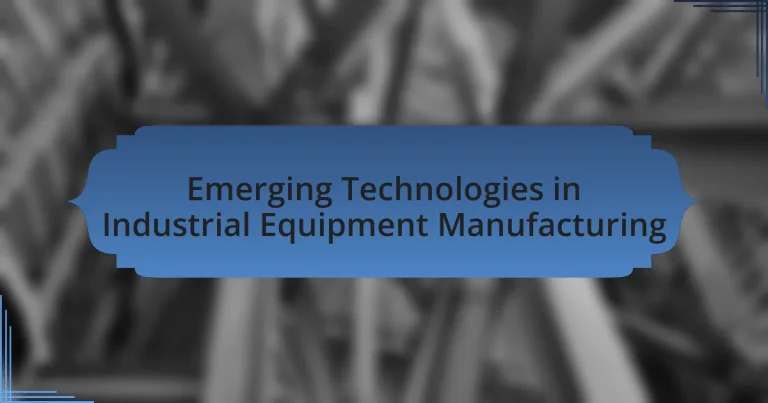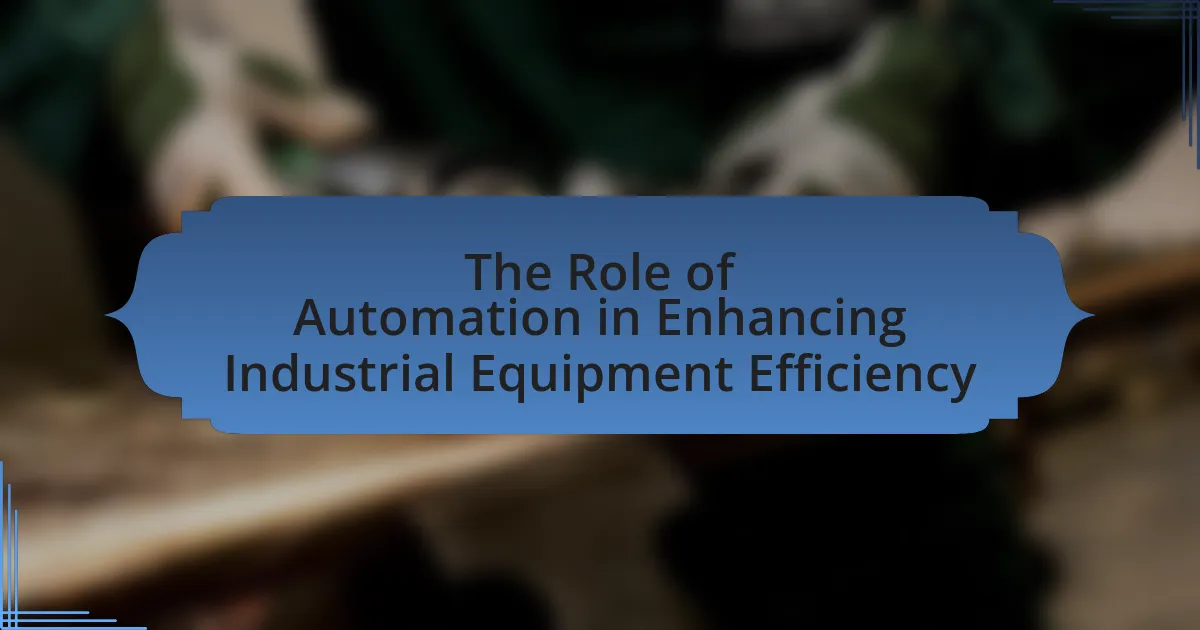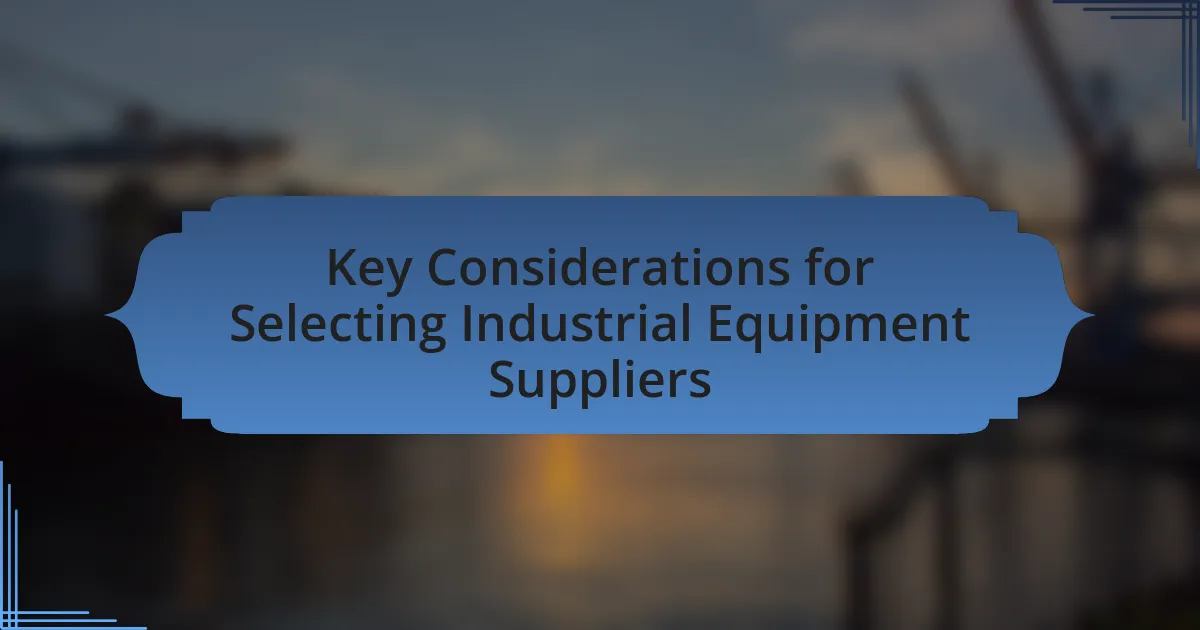Emerging technologies in industrial equipment manufacturing encompass advanced robotics, additive manufacturing (3D printing), the Internet of Things (IoT), artificial intelligence (AI), and augmented reality (AR). These technologies significantly enhance manufacturing efficiency, reduce costs, and improve product quality by automating processes, enabling real-time monitoring, and facilitating complex designs. The article explores the impact of these technologies on manufacturing processes, their role in sustainability, the challenges companies face during adoption, and best practices for successful implementation. Additionally, it addresses the financial implications and the importance of training and stakeholder engagement in integrating new technologies into existing systems.
What are Emerging Technologies in Industrial Equipment Manufacturing?

Emerging technologies in industrial equipment manufacturing include advanced robotics, additive manufacturing (3D printing), the Internet of Things (IoT), artificial intelligence (AI), and augmented reality (AR). These technologies enhance efficiency, reduce costs, and improve product quality. For instance, advanced robotics automate repetitive tasks, leading to increased productivity and precision. Additive manufacturing allows for complex designs and rapid prototyping, significantly shortening product development cycles. The IoT enables real-time monitoring and data collection, facilitating predictive maintenance and operational optimization. AI algorithms analyze vast amounts of data to improve decision-making processes. AR provides immersive training and maintenance support, enhancing workforce capabilities. Collectively, these technologies are transforming the landscape of industrial equipment manufacturing, driving innovation and competitiveness.
How do these technologies impact the manufacturing process?
Emerging technologies significantly enhance the manufacturing process by improving efficiency, precision, and flexibility. For instance, the integration of automation and robotics reduces labor costs and increases production speed, while technologies like additive manufacturing enable complex designs that traditional methods cannot achieve. According to a report by McKinsey & Company, companies that adopt advanced manufacturing technologies can see productivity gains of 20-30%. Additionally, the use of IoT devices allows for real-time monitoring and predictive maintenance, which minimizes downtime and optimizes resource allocation. These advancements collectively lead to a more streamlined and cost-effective manufacturing process.
What specific technologies are considered emerging in this field?
Emerging technologies in industrial equipment manufacturing include additive manufacturing, also known as 3D printing, which allows for the creation of complex parts with reduced waste. Another significant technology is the Internet of Things (IoT), enabling real-time data collection and analysis for improved operational efficiency. Additionally, artificial intelligence (AI) and machine learning are being integrated to enhance predictive maintenance and optimize production processes. Robotics and automation technologies are also advancing, facilitating increased precision and speed in manufacturing tasks. These technologies are reshaping the industry by driving innovation and efficiency.
How do these technologies enhance efficiency and productivity?
Emerging technologies in industrial equipment manufacturing enhance efficiency and productivity by automating processes, optimizing resource allocation, and improving data analysis. Automation reduces manual labor and minimizes human error, leading to faster production cycles. For instance, the implementation of robotics in assembly lines can increase output by up to 30%, as reported by the International Federation of Robotics. Additionally, technologies like IoT enable real-time monitoring of equipment, allowing for predictive maintenance that can reduce downtime by 20-50%, according to a study by McKinsey & Company. Furthermore, advanced data analytics tools facilitate better decision-making by providing insights into operational performance, which can lead to a 10-15% increase in overall efficiency.
Why is it important to adopt emerging technologies in manufacturing?
Adopting emerging technologies in manufacturing is crucial for enhancing efficiency and competitiveness. These technologies, such as automation, artificial intelligence, and the Internet of Things, streamline production processes, reduce operational costs, and improve product quality. For instance, a McKinsey report indicates that companies implementing advanced manufacturing technologies can increase productivity by up to 30%. Additionally, emerging technologies enable manufacturers to respond swiftly to market changes and customer demands, fostering innovation and sustainability in production practices.
What are the potential risks of not adopting these technologies?
The potential risks of not adopting emerging technologies in industrial equipment manufacturing include decreased competitiveness, inefficiency, and increased operational costs. Companies that fail to integrate advanced technologies such as automation, IoT, and AI may struggle to keep pace with competitors who leverage these innovations to enhance productivity and reduce waste. For instance, a study by McKinsey & Company found that companies adopting automation can increase productivity by up to 30%. Additionally, without these technologies, manufacturers may face higher labor costs and longer production times, leading to diminished profit margins and market share.
How do emerging technologies contribute to sustainability in manufacturing?
Emerging technologies contribute to sustainability in manufacturing by enhancing efficiency, reducing waste, and enabling the use of renewable resources. For instance, advanced manufacturing techniques such as additive manufacturing (3D printing) minimize material waste by using only the necessary amount of raw materials, which can lead to a reduction in overall resource consumption. Additionally, the integration of Internet of Things (IoT) devices allows for real-time monitoring of energy usage, enabling manufacturers to optimize processes and reduce energy consumption by up to 30%, as reported by the International Energy Agency. Furthermore, the adoption of artificial intelligence in predictive maintenance can extend the lifespan of machinery, thereby decreasing the frequency of replacements and the associated environmental impact. These technologies collectively support a more sustainable manufacturing ecosystem by promoting resource efficiency and minimizing environmental footprints.
What are the key types of emerging technologies in industrial equipment manufacturing?

Key types of emerging technologies in industrial equipment manufacturing include additive manufacturing, Internet of Things (IoT), artificial intelligence (AI), and robotics. Additive manufacturing, or 3D printing, allows for the creation of complex parts with reduced material waste and shorter lead times. The Internet of Things enables real-time data collection and analysis, enhancing operational efficiency and predictive maintenance. Artificial intelligence facilitates advanced analytics and decision-making processes, optimizing production workflows. Robotics improves automation and precision in manufacturing tasks, leading to increased productivity and safety. These technologies are transforming the industrial landscape by driving innovation and efficiency.
How does automation play a role in modern manufacturing?
Automation significantly enhances efficiency and productivity in modern manufacturing by streamlining processes and reducing human error. Automated systems, such as robotics and computer-controlled machinery, enable manufacturers to operate continuously with minimal downtime, leading to increased output. For instance, a study by McKinsey & Company found that automation can boost productivity by up to 30% in manufacturing settings. Additionally, automation allows for precise quality control, ensuring that products meet stringent standards consistently. This integration of technology not only lowers operational costs but also enables manufacturers to respond swiftly to market demands, thereby maintaining competitiveness in a rapidly evolving industry.
What are the benefits of robotics in industrial equipment manufacturing?
Robotics in industrial equipment manufacturing enhances efficiency, precision, and safety. Automated robotic systems can operate continuously without fatigue, leading to increased production rates and reduced cycle times. For instance, a study by the International Federation of Robotics reported that the use of industrial robots can boost productivity by up to 30%. Additionally, robots perform tasks with high accuracy, minimizing errors and waste, which is crucial in manufacturing processes where precision is vital. Furthermore, the integration of robotics reduces the risk of workplace injuries by taking over dangerous tasks, thereby improving overall safety for human workers.
How is artificial intelligence transforming manufacturing processes?
Artificial intelligence is transforming manufacturing processes by enhancing automation, improving predictive maintenance, and optimizing supply chain management. AI technologies, such as machine learning and computer vision, enable manufacturers to automate repetitive tasks, which increases efficiency and reduces human error. For instance, a study by McKinsey & Company found that AI can improve productivity in manufacturing by up to 20%. Additionally, AI-driven predictive maintenance allows companies to anticipate equipment failures before they occur, thereby minimizing downtime and maintenance costs. According to a report from Deloitte, predictive maintenance can reduce maintenance costs by 10-40% and increase equipment lifespan by 20-40%. Furthermore, AI optimizes supply chain management by analyzing vast amounts of data to forecast demand accurately, leading to better inventory management and reduced waste. This integration of AI into manufacturing processes not only streamlines operations but also drives significant cost savings and productivity gains.
What role does the Internet of Things (IoT) play in manufacturing?
The Internet of Things (IoT) plays a crucial role in manufacturing by enabling real-time data collection and analysis, which enhances operational efficiency. IoT devices, such as sensors and connected machinery, facilitate monitoring of production processes, allowing manufacturers to optimize workflows, reduce downtime, and improve product quality. For instance, a study by McKinsey & Company found that IoT applications in manufacturing can lead to a 10-20% increase in productivity and a 15-30% reduction in maintenance costs. This data-driven approach empowers manufacturers to make informed decisions, predict equipment failures, and streamline supply chain management, ultimately driving innovation and competitiveness in the industry.
How does IoT improve equipment monitoring and maintenance?
IoT improves equipment monitoring and maintenance by enabling real-time data collection and analysis from connected devices. This technology allows for continuous monitoring of equipment performance, which helps in identifying potential issues before they lead to failures. For instance, sensors can track temperature, vibration, and operational hours, providing insights that facilitate predictive maintenance strategies. According to a report by McKinsey, companies that implement IoT solutions can reduce maintenance costs by up to 30% and increase equipment uptime by 20-25%. This data-driven approach enhances decision-making and optimizes maintenance schedules, ultimately leading to increased efficiency and reduced operational costs.
What are the security concerns associated with IoT in manufacturing?
The security concerns associated with IoT in manufacturing include data breaches, unauthorized access, and vulnerabilities in connected devices. Data breaches can lead to the exposure of sensitive information, impacting both operational integrity and customer trust. Unauthorized access occurs when malicious actors exploit weak authentication protocols, potentially gaining control over critical systems. Additionally, vulnerabilities in connected devices, such as outdated firmware or lack of encryption, can be exploited to launch attacks, disrupting production processes. According to a report by the Ponemon Institute, 60% of organizations experienced a security incident related to IoT devices, highlighting the urgency of addressing these concerns in the manufacturing sector.
How are companies implementing these emerging technologies?

Companies are implementing emerging technologies in industrial equipment manufacturing by integrating automation, artificial intelligence, and the Internet of Things (IoT) into their production processes. For instance, manufacturers are utilizing AI-driven analytics to optimize supply chain management and predictive maintenance, which enhances operational efficiency and reduces downtime. According to a report by McKinsey, companies that adopt AI in their operations can increase productivity by up to 40%. Additionally, IoT devices are being deployed to monitor equipment performance in real-time, allowing for immediate adjustments and improved quality control. This integration of technologies not only streamlines production but also fosters innovation in product development and customer engagement.
What strategies are effective for integrating new technologies into existing systems?
Effective strategies for integrating new technologies into existing systems include conducting a thorough needs assessment, ensuring compatibility, and fostering a culture of continuous learning. A needs assessment identifies specific gaps and requirements, allowing for targeted technology selection that aligns with organizational goals. Ensuring compatibility involves evaluating existing infrastructure and selecting technologies that can seamlessly integrate, minimizing disruptions. Fostering a culture of continuous learning encourages employees to adapt to new tools and processes, which is crucial for successful implementation. Research indicates that organizations that prioritize these strategies experience smoother transitions and improved operational efficiency, as evidenced by a study from McKinsey & Company, which found that 70% of digital transformation efforts fail due to inadequate change management and employee engagement.
How can companies assess their readiness for technological adoption?
Companies can assess their readiness for technological adoption by conducting a comprehensive evaluation of their current capabilities, resources, and organizational culture. This assessment typically involves analyzing existing infrastructure, workforce skills, and alignment with strategic goals. For instance, a study by McKinsey & Company highlights that organizations with a clear digital strategy and skilled workforce are 1.5 times more likely to successfully adopt new technologies. Additionally, companies can utilize readiness assessment frameworks, such as the Technology Readiness Index, which measures factors like optimism, innovativeness, and discomfort regarding technology. This structured approach enables firms to identify gaps and areas for improvement, ensuring a more effective transition to emerging technologies in industrial equipment manufacturing.
What training is necessary for employees to adapt to new technologies?
Employees require comprehensive training programs that focus on technical skills, software proficiency, and change management to adapt to new technologies. Technical skills training ensures that employees understand the specific tools and machinery associated with emerging technologies, such as automation systems and advanced manufacturing equipment. Software proficiency training is essential for familiarizing employees with new software applications that support these technologies, enhancing their ability to operate and troubleshoot systems effectively. Change management training prepares employees for the psychological and organizational shifts that accompany technological advancements, fostering a culture of adaptability and continuous learning. Research indicates that organizations that invest in structured training programs experience a 30% increase in employee productivity and a 25% reduction in technology-related errors, demonstrating the effectiveness of targeted training in facilitating technology adaptation.
What challenges do companies face when adopting emerging technologies?
Companies face several challenges when adopting emerging technologies, including high implementation costs, integration with existing systems, and a lack of skilled workforce. High implementation costs can deter investment, as companies may struggle to justify the initial expenditure against potential long-term benefits. Integration with existing systems poses a significant hurdle, as legacy systems may not be compatible with new technologies, leading to operational disruptions. Additionally, the lack of a skilled workforce can hinder effective adoption, as companies may find it difficult to recruit or train employees with the necessary expertise to manage and utilize these technologies effectively. According to a report by McKinsey, 70% of digital transformation initiatives fail due to these challenges, highlighting the critical nature of addressing them for successful technology adoption.
How can companies overcome resistance to change within their workforce?
Companies can overcome resistance to change within their workforce by implementing effective communication strategies and involving employees in the change process. Engaging employees through transparent discussions about the reasons for change and the benefits it brings fosters a sense of ownership and reduces anxiety. Research indicates that organizations that actively involve employees in decision-making during transitions experience 70% higher success rates in change initiatives. Additionally, providing training and support helps employees adapt to new technologies, further mitigating resistance.
What are the financial implications of investing in new technologies?
Investing in new technologies has significant financial implications, including both initial capital expenditures and potential long-term cost savings. Companies often face high upfront costs for research, development, and implementation of new technologies, which can strain budgets and require careful financial planning. However, these investments can lead to increased efficiency, reduced operational costs, and enhanced product quality, ultimately resulting in higher profitability. For instance, a study by McKinsey & Company found that companies that adopt advanced manufacturing technologies can reduce production costs by up to 30%. Thus, while the initial financial outlay may be substantial, the potential for improved financial performance and competitive advantage makes investing in new technologies a strategic decision for industrial equipment manufacturers.
What best practices should companies follow when adopting emerging technologies?
Companies should follow a structured approach when adopting emerging technologies, focusing on strategic alignment, stakeholder engagement, and continuous evaluation. Strategic alignment ensures that the technology adoption aligns with the company’s overall goals and objectives, which is crucial for maximizing return on investment. Stakeholder engagement involves involving key personnel from various departments to gather insights and foster a culture of innovation, which can enhance the implementation process. Continuous evaluation allows companies to assess the effectiveness of the technology and make necessary adjustments, ensuring that the technology remains relevant and beneficial over time. These practices are supported by research indicating that organizations with a clear strategy and stakeholder involvement are more likely to succeed in technology adoption, as evidenced by a study from McKinsey & Company, which found that 70% of successful digital transformations involved strong leadership and employee engagement.
How can companies measure the success of technology implementation?
Companies can measure the success of technology implementation through key performance indicators (KPIs) that align with their strategic objectives. These KPIs may include metrics such as return on investment (ROI), operational efficiency improvements, user adoption rates, and customer satisfaction scores. For instance, a study by McKinsey & Company found that organizations that effectively track and analyze these metrics can achieve up to 20% higher productivity and 30% lower operational costs post-implementation. By continuously monitoring these indicators, companies can assess the impact of technology on their processes and make informed decisions for future investments.
What are the common pitfalls to avoid during the adoption process?
Common pitfalls to avoid during the adoption process of emerging technologies in industrial equipment manufacturing include inadequate planning, lack of stakeholder engagement, and insufficient training. Inadequate planning can lead to misalignment between technology capabilities and business needs, resulting in wasted resources. Lack of stakeholder engagement often results in resistance to change, as employees may feel excluded from the decision-making process. Insufficient training can hinder the effective use of new technologies, leading to decreased productivity and increased frustration among users. These pitfalls are supported by industry reports indicating that organizations that prioritize comprehensive planning, inclusive communication, and robust training programs are more successful in technology adoption.




